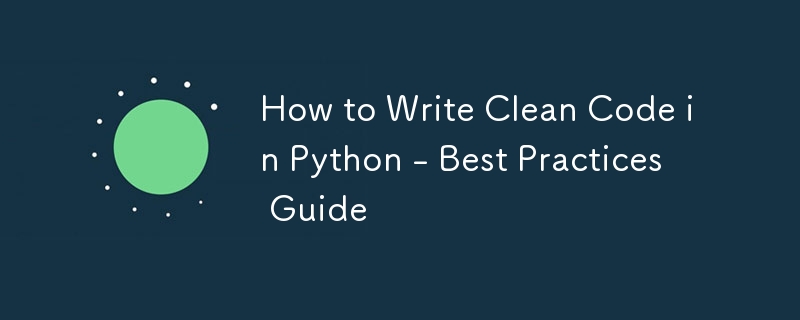
編寫 Python 程式碼時,必須使其乾淨且易於閱讀。乾淨的程式碼意味著您的程式碼組織良好、易於理解且易於維護。在本指南中,我們將分享最佳技巧,幫助您用 Python 編寫乾淨的程式碼,無論您是初學者還是經驗豐富的開發人員。
編寫乾淨的程式碼至關重要,原因有很多:
提高程式碼可讀性最簡單的方法之一是為變數和函數使用清晰且有意義的名稱。避免使用單字母或神秘的名稱,例如 x、y 或 foo。
範例:
# Bad example
def calc(x, y):
return x + y
# Good example
def calculate_total_price(item_price, tax):
return item_price + tax
在第二個範例中,只要查看函數名稱和變數名稱就很容易理解函數的作用。
PEP 8 是 Python 的官方風格指南,提供了編寫乾淨且可讀的程式碼的約定。一些關鍵的 PEP 8 建議包括:
範例:
# PEP 8 Example
def calculate_discounted_price(price, discount):
"""Calculate the final price after applying the discount."""
discounted_amount = price * (discount / 100)
final_price = price - discounted_amount
return final_price
將程式碼分解為更小的、可管理的函數。每個函數應該執行一項特定任務,使其更易於閱讀、測試和調試。
範例:
# Bad example
def process_order(customer, items):
total_price = 0
for item in items:
total_price += item['price']
if total_price > 100:
discount = total_price * 0.1
total_price -= discount
# Send email
print(f"Order confirmed for {customer['name']}")
return total_price
# Good example
def calculate_total_price(items):
return sum(item['price'] for item in items)
def apply_discount(total_price):
if total_price > 100:
return total_price * 0.9
return total_price
def send_confirmation_email(customer):
print(f"Order confirmed for {customer['name']}")
def process_order(customer, items):
total_price = calculate_total_price(items)
total_price = apply_discount(total_price)
send_confirmation_email(customer)
return total_price
在改進的範例中,程式碼被拆分為更小的函數,使其更易於理解和維護。
Python 中的清單推導式提供了一種建立清單的簡潔方法。使用它們可以使您的程式碼更乾淨、更具可讀性。
範例:
# Without list comprehension
squares = []
for x in range(10):
squares.append(x ** 2)
# With list comprehension
squares = [x ** 2 for x in range(10)]
第二個範例更短且更易於閱讀。
避免直接在程式碼中對值進行硬編碼。相反,請使用常數或設定檔。這使您的程式碼更加靈活且更易於更新。
範例:
# Bad example
def calculate_discount(price):
return price * 0.1 # Discount is hardcoded
# Good example
DISCOUNT_RATE = 0.1
def calculate_discount(price):
return price * DISCOUNT_RATE
在第二個範例中,折扣率儲存在常數中,以便在需要時更容易更改。
雖然乾淨的程式碼應該是不言自明的,但添加註解和文件字串可以幫助解釋複雜函數或演算法的目的。
def find_largest_number(numbers):
"""
Find the largest number in a list.
Args:
numbers (list): A list of numbers.
Returns:
int: The largest number.
"""
return max(numbers)
文件字串可協助其他開發人員了解如何使用該函數,而無需閱讀整個程式碼。
避免重複程式碼。如果您發現重複的模式,請嘗試重構程式碼以重複使用函數或類別。這將使您的程式碼更易於維護並減少出錯的機會。
範例:
# Bad example
def get_full_name1(first_name, last_name):
return first_name + " " + last_name
def get_full_name2(first_name, last_name):
return first_name + " " + last_name
# Good example
def get_full_name(first_name, last_name):
return first_name + " " + last_name
總是使用 try 和 except 區塊來處理異常,以防止程式崩潰。您還應該提供資訊豐富的錯誤訊息以使偵錯更容易。
範例:
# Bad example
def divide_numbers(a, b):
return a / b
# Good example
def divide_numbers(a, b):
try:
return a / b
except ZeroDivisionError:
return "Error: Cannot divide by zero"
第二個範例可防止崩潰並提供有用的錯誤訊息。
Python 3.6 引入了 f-string,這是一種簡單易讀的字串格式設定方法。它們比舊的字串格式化方法乾淨得多。
範例:
# Old way
name = "Alice"
greeting = "Hello, %s!" % name
# With f-strings
greeting = f"Hello, {name}!"
F 字串使您的程式碼更易於閱讀和維護。
Only import the necessary modules and functions. Avoid wildcard imports like from module import * as they can clutter the namespace and make it harder to track dependencies.
Example:
# Bad example from math import * # Good example from math import sqrt, pi
Writing clean code in Python is a valuable skill that helps you create readable, maintainable, and bug-free software. By following the best practices outlined in this guide—using meaningful names, following PEP 8, keeping your code modular, and handling errors gracefully—you can significantly improve your coding style.
Focus on readability, simplicity, and consistency, and you'll be well on your way to writing clean, professional Python code.
以上是如何用 Python 寫乾淨的程式碼 - 最佳實踐指南的詳細內容。更多資訊請關注PHP中文網其他相關文章!




